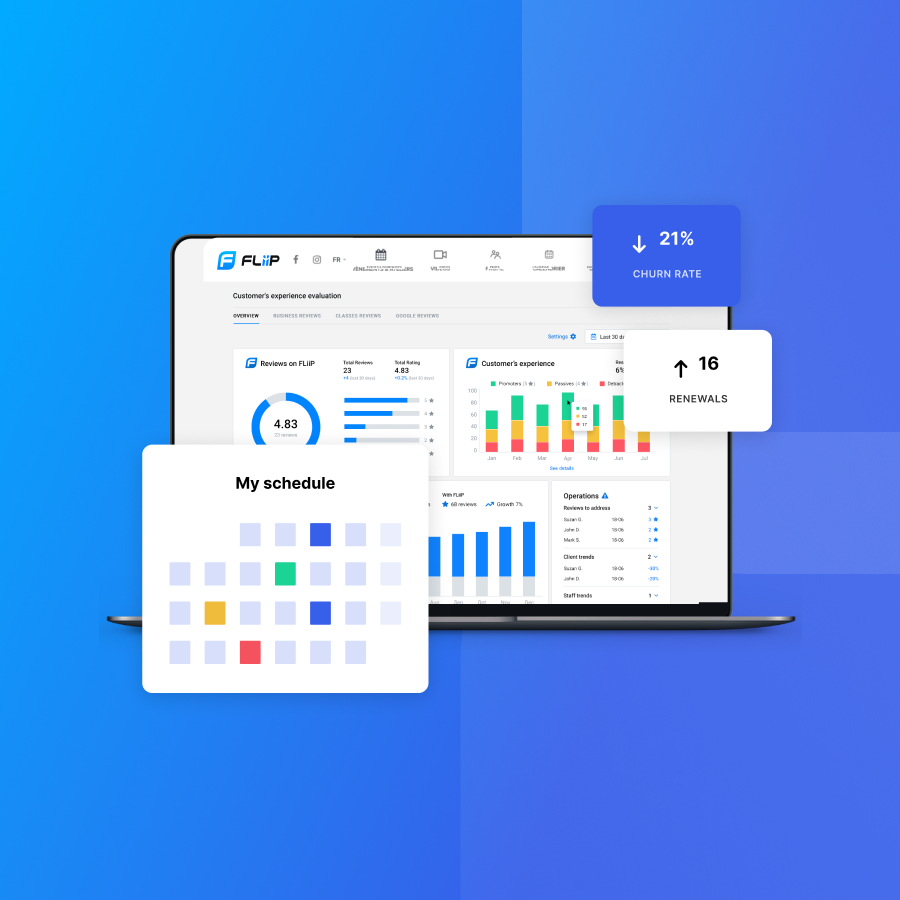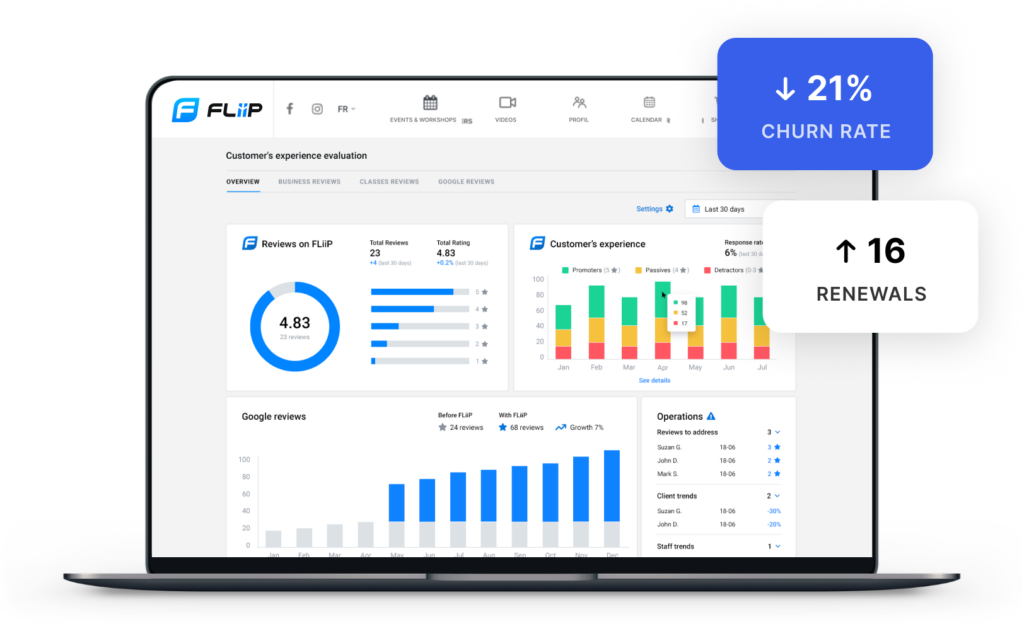Essential Metrics Every Gym Owner Should Track for Growth

Running a successful gym demands passion for fitness and a knack for leadership, but it also requires making informed decisions based on solid data. Keeping an eye on metrics is essential to overcome the daily challenges of managing memberships and optimizing operations.
In this article, I’m cutting through the complexity to show you the metrics that genuinely matter for your gym’s growth so you can make informed decisions, improve member satisfaction, and contribute to your revenue growth.
Understanding Your Numbers
One of the earliest lessons many of us learn in growing a gym is the importance of understanding our sales numbers. It’s a straightforward mantra that resonates across all businesses: “If you can’t measure it, you can’t manage it.” Without a firm grasp on your numbers, steering your gym towards growth and sustainability becomes a shot in the dark.
Even if you haven’t established a formal tracking system, you probably already know your gym’s core metrics instinctively. But to truly harness the power of this data, you need to track and analyze these metrics.
Leads Generated by Marketing
The first step in optimizing your gym’s sales funnel begins with establishing what constitutes a lead within your organization and how to track them. Is it an individual who engages with your content online, signs up for a free trial, or schedules a consultation call with a membership advisor?
Recognizing that these actions indicate varying levels of interest is crucial. For instance, someone downloading a fitness guide from your website shows interest but might not be as ready to commit as another who schedules a direct consultation. These differences suggest that segmenting your leads based on their source or the type of interaction they’ve had with your gym can provide valuable insights.
Segmentation allows you to monitor the performance of different lead sources and types. This nuanced approach helps you identify which channels are most effective at generating qualified leads and which leads are more likely to convert into memberships. With this knowledge, you can refine your lead generation strategies, ensuring you invest your resources in the most promising areas.
How to Track: Use marketing analytics tools and CRM software to track leads from various channels. Assign unique codes or tracking URLs to specific campaigns for easier identification.
How to Improve: Enhance your marketing strategies based on the channels that generate the most leads. Invest in high-performing channels and experiment with different messages and audiences.
Conversion Rate
Understanding the efficiency of your gym’s sales funnel critically hinges on analyzing your conversion rate. This metric measures the percentage of leads that transform into paying members, providing a direct insight into the effectiveness of your sales and marketing strategies.
The conversion rate reflects not only the quality of the leads generated but also how well your team engages with potential members. A higher conversion rate indicates that your gym is successfully meeting your audience’s needs and expectations, compelling them to join.
How to Track: To calculate your conversion rate, keep a close record of the number of leads who evolve into paying members over a given time frame. The formula to determine your conversion rate is quite straightforward:
Conversion Rate = (Number of Conversions / Number of Leads) x 100
For instance, if in one month your gym garners 100 leads and 20 of these leads sign up for memberships, the calculation of your conversion rate would be as follows:
Conversion Rate = (20 / 100) x 100 = 20%
This outcome signifies that 20% of the leads in that specific period decided to join your gym. Tracking this metric and implementing strategies for its improvement is pivotal for enhancing the effectiveness of your sales and marketing endeavors and pinpointing areas in the lead conversion process that may require refinements.
How to Improve:
- Regularly update your sales team’s training to ensure they possess the skills and knowledge necessary for effective lead conversion.
- Examine and optimize your sales journey to eliminate any hurdles that could deter potential members.
- Personalize your communication based on the leads’ demonstrated interests and previous engagements.
- Experiment with different sales pitches, offers, or communication channels to see which yields higher conversion rates.
Monthly Recurring Revenue (MRR)
MRR offers a clear picture of your gym’s predictable income derived from memberships, providing a solid foundation for making informed operational and strategic decisions. Understanding and optimizing your MRR will help you better plan for growth, manage cash flow, and assess your business’s overall health.
How to Calculate MRR: Calculating MRR is straightforward. Simply multiply the number of active members by the average revenue per member per month. For instance, if your gym has 200 active members and the average monthly membership fee is $50, your MRR would be:
MRR= Number of Active Members × Average Revenue per Member
MRR = 200 members x $50 per member = $10,000
This calculation gives you a quick snapshot of your monthly expected income from memberships, excluding one-time payments or non-recurring revenue sources.
How to Track and Improve MRR: To effectively track MRR, consider using accounting or gym management software to automate this process, providing regular updates and insights. Improving your MRR involves strategies aimed at increasing the number of active members, enhancing the average revenue per member, or both. Here are a few initiatives:
- Implement programs focused on retaining existing members, as maintaining a stable membership base is crucial for MRR.
- Offer additional services or products that complement your members’ fitness journeys, such as personal training sessions or nutrition coaching.
- Encourage your current members to refer friends or family by offering incentives for both the referrer and the new member.
Average Yield per Member
The Average Yield per Member is a critical metric that shows the financial contribution of each member to your gym. It goes beyond basic membership fees, encompassing all revenue generated per member, including fees for additional services like personal training, classes, merchandise purchases, and any other ancillary revenue streams. This metric is invaluable for understanding member behavior, preferences, and the overall value they bring to your gym.
A higher average yield indicates that members are engaging more with your gym’s services and products, contributing more to your gym’s financial health.
How to Track: To calculate the Average Yield per Member, you must divide the total revenue (including all sources) by the total number of active members over a specific period.
Average Yield per Member = Total Revenue / Number of Active Members
For example, if your gym generates $20,000 in total revenue from 200 active members in a month, the calculation would be:
Average Yield per Member = $20,000 / 200 = $100
How to Improve:
- Implement targeted marketing campaigns, offer personalized fitness plans, and encourage feedback to boost utilization of additional services to increase member engagement.
- Introduce and regularly evaluate new services, classes, or products that align with your members’ changing needs and interests.
- Encourage members to upgrade their memberships for exclusive benefits or discounts on additional services.
- Promote bundled services or products at special rates to motivate members to explore new offerings, potentially leading to more spending.
Time from Lead to Close
Understanding how swiftly your gym converts leads into paying members is crucial for assessing the efficiency of your sales process.
How to Calculate: To calculate this time frame, you need precise records of when leads enter your sales funnel and the moment they convert into paying members. Most CRM (Customer Relationship Management) or gym management software can track these dates automatically. For each lead that converts, calculate the elapsed time between their initial entry into your system and their conversion date:
Time from Lead to Close = Conversion Date − Lead Entry Date
For example, if a lead entered your system on June 1st and became a paying member on June 15th, the time from lead to close would be 14 days.
How to Improve:
- Review your sales funnel for any unnecessary steps that could be causing delays. Simplify the process as much as possible without sacrificing the quality of interactions.
- Develop targeted lead nurturing campaigns that provide value and maintain engagement. Tailored communication can help move leads through the sales funnel more quickly.
- Ensure your sales team is well-trained in identifying high-potential leads and effectively closing sales. Regular training and role-playing exercises can improve their efficiency and conversion rates.
- Regularly review your sales process to identify and address any bottlenecks. This might involve adjusting policies, improving communication channels, or implementing new sales tools.

Class Attendance and Participation Rates
Keeping track of class attendance and participation rates is vital for gauging the popularity and effectiveness of your gym’s class offerings. Monitoring these rates helps identify trends over time, revealing which classes consistently attract a high number of participants and which ones struggle to maintain interest. This data can inform decisions about scheduling, instructor performance, and even marketing efforts to increase class participation.
How to Track
- Use your gym management software to record attendance for each class. Most modern gym software solutions offer functionalities to check members in and out of classes digitally, simplifying this process.
- Calculate the participation rate by dividing the number of attendees by the class capacity and multiplying by 100 to get a percentage. This gives you an idea of how full your classes are.
- Analyze trends over time by comparing participation rates across different periods, instructors, or class types.
For example, if a yoga class can accommodate 20 participants and 15 members attend, the participation rate for that class is:
Participation Rate = (15 / 20) x 100 = 75%
This calculation shows that the class was filled to 75% of its capacity, clearly showing its popularity and appeal.
How to Improve
- Identify peak times and popular formats, then adjust your class schedule to maximize attendance.
- Promote under-attended classes through targeted marketing campaigns, special offers, or events designed to increase interest and participation.
- Ensure that instructors are engaging and motivating, as their performance directly impacts class popularity.
Revenue per Membership Consultant
Understanding the revenue generated by each membership consultant provides critical insight into the productivity and effectiveness of your sales team. This metric assesses the financial contribution of individual consultants to your gym’s overall revenue, highlighting their ability to convert leads into paying members and upsell additional services.
How to Track
- Gather all revenue attributed to new memberships, renewals, and any upsell or additional services sold by each consultant within a specific period.
- Ensure your gym software accurately records which consultant is responsible for each sale, allowing for precise revenue attribution.
- Divide the total revenue attributed to each consultant by the total number of sales they made. This gives you the average revenue generated per sale, per consultant.
For example, if a membership consultant is responsible for selling 50 memberships in a month, and these memberships along with additional services, total $10,000 in revenue, the revenue per membership consultant would be:
Revenue per Membership Consultant = Total Revenue / Total Number of Sales
Revenue per Membership Consultant = ($10,000 / 50) = $200
This calculation indicates that, on average, each sale made by this consultant generates $200 in revenue for your gym.
How to Improve
- Provide your sales team with continuous training and development opportunities. Focus on improving sales techniques, product knowledge, and customer service skills.
- Implement incentive programs that reward consultants for achieving or exceeding revenue targets.
- Equip your sales team with effective tools and resources, such as up-to-date marketing materials, CRM software, and sales scripts. These tools can help consultants manage leads more efficiently and close sales more effectively.
- Offer regular feedback and coaching sessions. Review performance metrics with each consultant, discuss areas for improvement, and set clear goals for the future.
Conclusion
Harnessing the right metrics is your secret weapon in the competitive fitness industry. It’s about taking action!
Start with a laser focus on a few metrics, mastering them to create immediate impacts. As you gain momentum, gradually incorporate more data points, weaving them into a comprehensive strategy that propels your gym forward.
Armed with the power of data, you’re not just keeping pace; you’re setting the pace, creating a stronger, more engaged, and more resilient fitness community.



